‘Leave the World Behind’ Filmmaker Sam Esmail on Those ‘Mr. Robot’ Connections and Using the ‘Ocean’s Twelve’ Playbook
- Oops!Something went wrong.Please try again later.
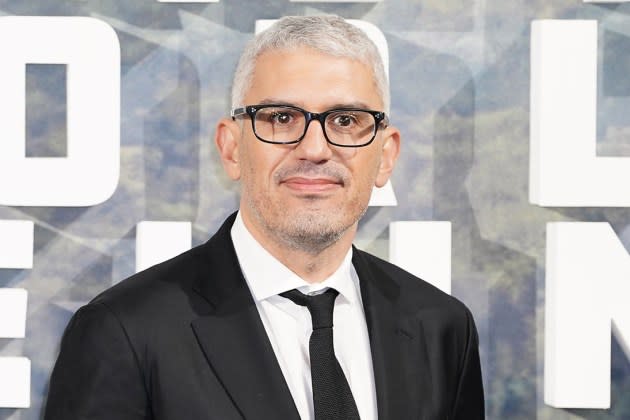
[This story contains spoilers for Leave the World Behind.]
Sam Esmail’s Leave the World Behind currently ranks atop Netflix’s film chart, and longtime fans of the filmmaker are now decoding its place in his greater universe of storytelling.
More from The Hollywood Reporter
Inside 'Mr. Robot' Creator Sam Esmail's Carefully Curated L.A. Headquarters
Why Sam Esmail Cast America's Sweetheart Julia Roberts as a "Karen"
Ten minutes into the thriller, Mr. Robot buffs likely picked up on a familiar site: a yellow emergency preparedness kit with the branding of the USA series’ villainous corporation, E-Corp. That bucket would serve as one of several early signals that a cyberattack would incite the film’s imminent disaster and systematic destabilization of the United States. Esmail had already wanted to make a disaster film that revolved around a cyberattack, and when he read Rumaan Alam’s novel, Leave the World Behind, he knew he could merge that idea with his existing universe of stories, not just Mr. Robot.
“It felt pretty natural, and to be honest with you, I didn’t just do it with Mr. Robot. There are little nods to everything I’ve worked on, from Homecoming and Comet to Robot,” Esmail tells The Hollywood Reporter. “I fancy myself as creating my own little universe whenever I make a film, so I thought to myself, ‘Why not connect them all?’ It’s more fun that way.”
The film centers around the Sandford family and their calamitous weekend getaway at the Long Island home of G.H Scott (Mahershala Ali). Rose Sandford (Farrah Mackenzie), the daughter of Julia Roberts’ Amanda and Ethan Hawke’s Clay, is a Friends obsessive who’s unable to watch the series finale due to the abrupt loss of an Internet connection. However, she pays no mind to the fact that her mother looks identical to Roberts’ own Friends character, Susie Moss, from season two’s “The One After the Superbowl.”
In this case, Email is taking a page out of the Ocean’s Twelve playbook where Roberts played both her similar-looking character, Tess Ocean, and herself in the same universe.
“The universe I create for these movies is slightly off from our reality. They have to be, obviously. They’re being performed by actors that are in our world,” Esmail says. “So my meta, convoluted explanation is that when Rose is watching Friends and she sees Julia on it, she sees a passing resemblance to her mother, but obviously shrugs it off because it’s not her mom.”
With the end of the world potentially in reach, Rose stops at nothing to complete her Friends-viewing experience, so she tracks down a nearby mansion with a doomsday bunker. Naturally, the place is stocked to the gills, and that includes a healthy physical media collection. This results in the film’s penultimate shot where Rose bypasses the Netflix button on a remote control to press play on the Friends series finale, “The Last One.”
To pull this moment off, Esmail opted for the mindset that it’s easier to ask for forgiveness than to get permission, but much to his surprise, the shot went unchallenged by Netflix.
“I shot it, I put it in the film, I showed it to Netflix and I just crossed my fingers,” Esmail recalls. “That was literally my only strategy, and to their credit, they didn’t say anything. They didn’t react and I didn’t ask. So I’ll just leave it at that.”
Below, during a recent spoiler conversation with THR, Esmail also discusses how helpful Guillermo Del Toro and Rian Johnson were during post-production.
“Hello, friend.” Exciting time in your world right now.
(Laughs.) Look at you. Yeah, it is.
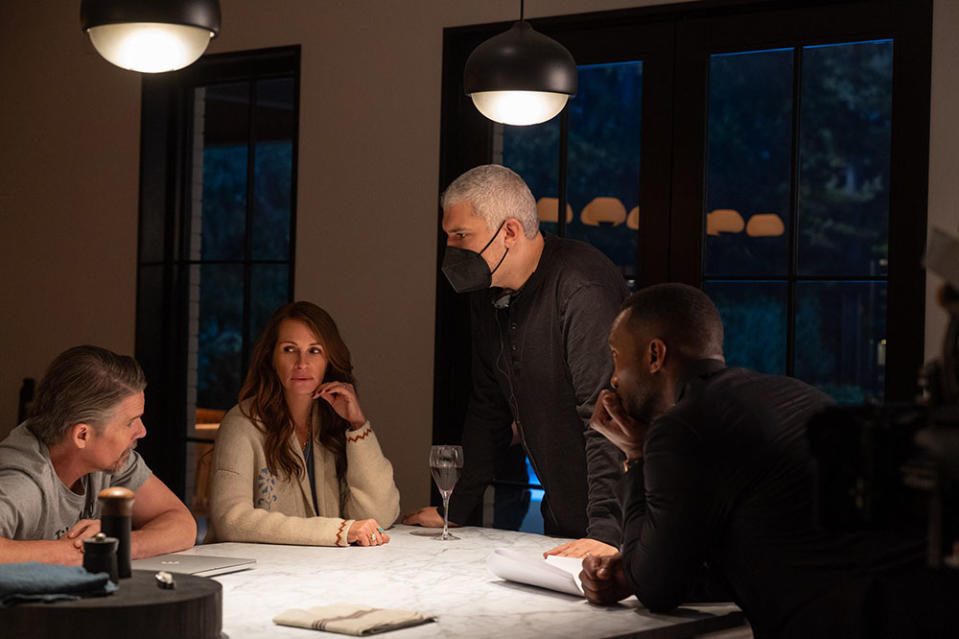
Well, I didn’t know much about Leave the World Behind other than the Mr. Robot brain trust being behind it, so you can imagine my surprise when I found myself pointing at Mr. Robot’s yellow E-Kit bucket a la Leo DiCaprio.
(Laughs.)
And then it kept happening with the E-Corp laptop and references to blackouts, hackers, cyberattacks and a near meltdown in New Jersey.
Wow, you really picked up on all of them.
I know Leave the World Behind is based on a book, but you’ve clearly retrofitted this story for the Mr. Robot universe, right?
It felt pretty natural, and to be honest with you, I didn’t just do it with Mr. Robot. There are little nods to everything I’ve worked on, from Homecoming and Comet to Robot. I fancy myself as creating my own little universe whenever I make a film, so I thought to myself, “Why not connect them all?” It’s more fun that way.
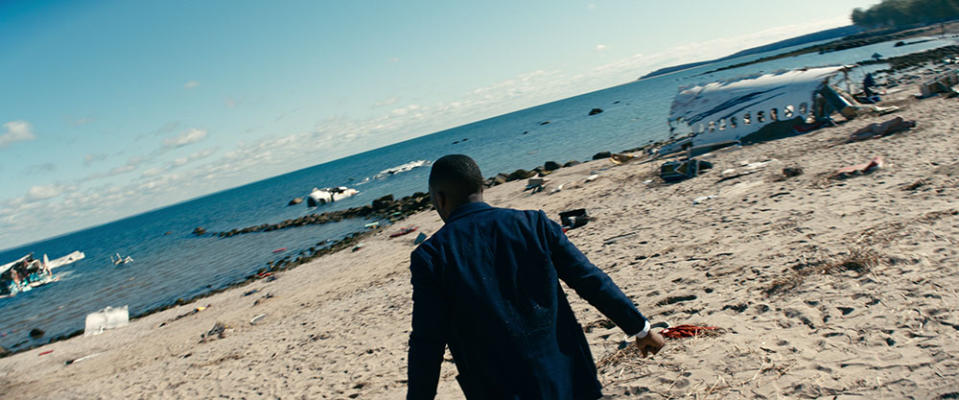
When you first read the book, did it just feel like an extension of your world in a lot of ways?
Before I read the book, I had been toying with the idea of making a disaster film centered around a cyberattack. As much as that word gets thrown around out there and as ominous as it might feel, it’s equally mystifying. I don’t know if people really grasp what that would look like or how that would feel, and so I thought that was just such fertile ground for a film. And then I read this book where [author] Rumaan Alam really takes a disaster thriller and flips it. What’s front and center about the book are the characters, and the disaster elements were off in the distance and pretty vague. And immediately, I just thought about grafting my cyberattack obsessions onto those disaster elements. It just fit so perfectly given the anxieties about technology among the characters and their reliance on it. So, in a weird way, it was a match made in heaven, and I’m lucky that Rumaan responded to those changes, too.
Of course, there’s a greater purpose to the E-Kit bucket scene, as they eventually need Danny (Kevin Bacon), but was the Flatliners reunion between Julia and Kevin another goal of it?
Oh my God, absolutely. It’s a little bit like Homecoming when I brought Dermot [Mulroney] and Julia back together after My Best Friend’s Wedding. I always love doing that. I’m a child of the ‘80s and ‘90s, and to work with these heroes of mine is always a treat. The same goes for Ethan, who I’ve adored since I was in high school. So it was great to get some of these actors together. In fact, I believe this is the first movie Ethan and Kevin have been in together.
I noticed that as well. It’s also the first time for Ethan and Julia.
Yeah, I thought that was crazy, too, because it seems like they would’ve naturally have done something in the past. So I love to take credit for the fact that I brought them all together in a movie, finally.
There’s a Friends component of this movie that’s very significant, and considering that Julia was on that show, did you opt for the Ocean’s Twelve approach where actual Julia and a Julia-looking character exist in the same universe?
Absolutely. This goes back to what I was just saying. The universe I create for these movies is slightly off from our reality. They have to be, obviously. They’re being performed by actors that are in our world. So my meta, convoluted explanation is that when Rose [Farrah Mackenzie] is watching Friends and she sees Julia on it, she sees a passing resemblance to her mother, but obviously shrugs it off because it’s not her mom. Kids also don’t like to imagine their moms being these famous celebrities that they see on TV, so that’s how I justify it to myself.
So Homecoming’s Heidi Bergman is also walking around in this universe.
Absolutely. I don’t know if you caught the Geist Easter eggs, but they’re also included in the film.
The antifreeze jug, when G.H. retrieves the satellite phone, is one.
Yeah. So Heidi Bergman is out there, too, and she gets the same treatment from strangers on the street, saying, “Hey, you look like that one actor.” It’s kind of like how I always get mistaken for George Clooney. (Laughs.) We just have this uncanny resemblance that you can’t deny.
Netflix lost the license to Friends in 2019, so how much back-and-forth was there about that choice? Did they try to steer you towards something they currently own or license?
Not at all. In fact, they were so in love with that choice, and from a story perspective, it just made perfect sense. It’s such an iconic show and a global phenomenon. It was not only resonant back in the day, but it’s also had this resurgence now across generations. So it just made perfect sense that Rose would be as obsessed as she is in the movie, and they were fully supportive of us committing to that.
This movie might be the greatest endorsement of physical media ever, and the timing is perfect since Guillermo Del Toro, Christopher Nolan and James Cameron have all been going to bat for it in recent weeks. So how did you get away with that remote control shot where Rose bypasses the Netflix button to press play on a Friends Blu-ray?
I shot it, I put it in the film, I showed it to Netflix and I just crossed my fingers. That was literally my only strategy, and to their credit, they didn’t say anything. They didn’t react and I didn’t ask. So I’ll just leave it at that.
Obviously, I’m a huge champion of physical media. I’m a huge champion of theatrical release, and I understand that it’s a conflict of interest, given that you can kind of blame streaming for, potentially, the demise of both. But to the credit of streamers, when I was growing up pre-Internet, I didn’t have access to a lot of movies by a lot of filmmakers, and if it wasn’t at my Blockbuster or even the local artsy video store that was in my small New Jersey town, I just wouldn’t see it. And so I’m always torn because I do see the value in having access to all these great classics that you otherwise wouldn’t have access to, especially in the quality that they’re in. So, as much as I am a proponent of theatrical and physical media, I do see the value in streamers as well.
I saw that you thanked Guillermo and Rian Johnson in the credits among others. I’ve heard a lot of stories involving those guys offering notes on early cuts, especially Guillermo. So did they in fact lend a hand?
One thousand percent. Guillermo is a mensch. He’s a filmmaker’s filmmaker. He really cares, and the thing that blew me away about his feedback is that he’s really honest. So he gave notes and he gave criticisms, but they never once felt disrespectful or hurtful. It was just about being a cheerleader for the movie. And same with Rian. I feel so honored that these two masters were able to watch the film and give me feedback. They’re really just out to support filmmakers and to support watching good movies, and so it was pretty flattering to get their support.
This movie underscores one of my greatest fears coming out of Covid, as there’s now a playbook to destabilize us. It was already known to some, but it’s now apparent that division and dysfunction can be created with relative ease. Was this on your mind as you put this together?
Oh yeah! Whenever I set out to do anything that’s fictional, and this is fictional … I sometimes feel like I need to repeat that. (Laughs.) This is speculative. I am taking what’s out there in the world and shifting around some variables, and then asking the what-if question. But what gives me anxiety is when reality overlaps. It frightens me because I feel like the lines between reality and what I’m creating are a lot farther than what actually happens. In the case of Mr. Robot, I remember episodes would air, and then our storyline would sort of happen in the real world. And with this film, I give the credit mostly to Rumaan. He wrote this book prior to the pandemic, and when I read it, it touched a nerve. It touched on this theme about how we lose our common humanity in the face of crisis, which was happening [during the pandemic]. So the fact that he was so prescient about that is remarkable and timely, and that’s what makes the story so compelling. But on the other hand, it’s really fucking scary.
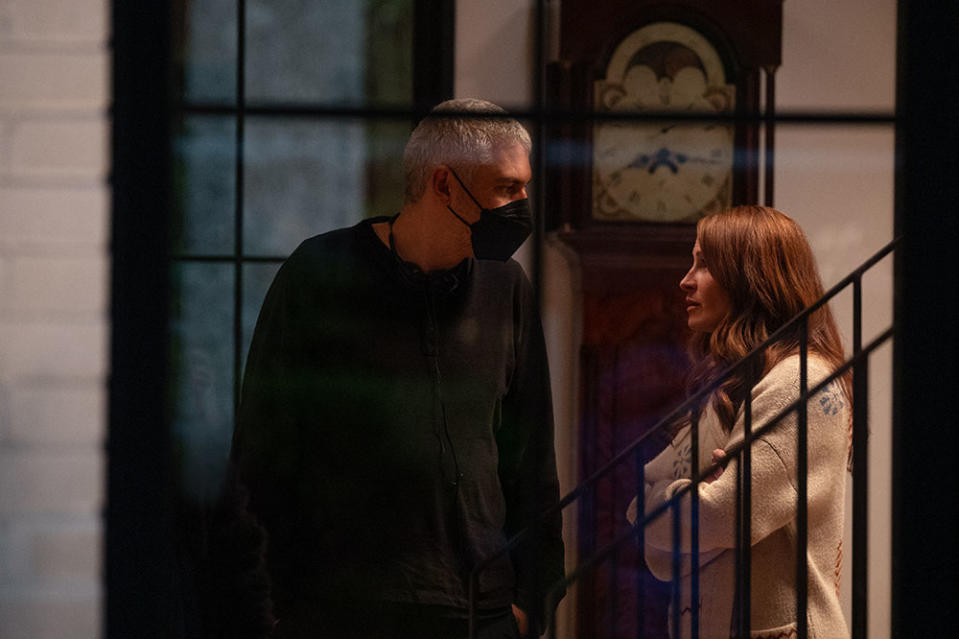
As is the case with all your work, the camera is a character in its own right, and you’ve got what I can only describe as a corkscrew camera move, like the oner that tracks Julia to the master bedroom. So what did you and DP Tod Campbell set out to do on this one in relation to your other work?
It’s always about the story. Of course, we’ve created a toolkit as we’ve worked together over the years, and so we have a shorthand in terms of how to pull off one of those moments that we think might add to the story. But specifically with that shot, we wanted to really harness the unmotivated camera moves that Hitchcock did so well. They added this sense of dread and foreboding that only an unmotivated camera can do, and when Julia’s character, Amanda, is going through the house, we started to do this sort of flipping around. It reflects the dizzying heights that she was feeling because she’s finally getting this weekend getaway that she’s been craving, but it does it to such an extent that it starts to feel literally sickening. Even Julia started to get nauseous watching that shot, and it was all intentional.
So the idea of being playful with the camera sets up this grammar and visual aesthetic. Even in this innocuous moment where she’s happy and taking in her surroundings, there’s something disorienting underneath it, and we do that throughout the film. In fact, we ended up doing that shot so much that we referred to it on set as the swizzle, and we tried to employ it whenever we could. It became this inside thing that we had on set, but it always begins and ends with character and audience. The relationship between the two really starts and ends with the camera.
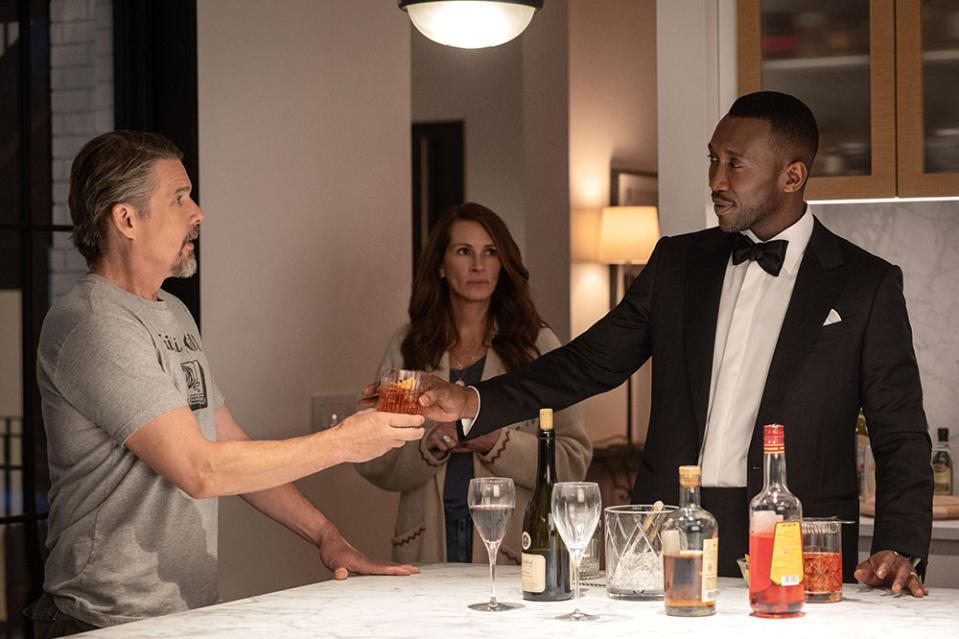
This project started out as a Pelican Brief reunion between Julia and Denzel, but I can’t imagine anyone other than Mahershala Ali in the role of G.H. now. Of course, it still would’ve been great the other way, but did things ultimately work out for the best?
Well, there’s no question that, now, having made the movie and having watched the movie, I, like you, can’t picture anyone else but Mahershala in that role. He’s just incredible. And when I set out to cast that role, I always pictured G.H. as this Hitchcockian stereotype, kind of like a Cary Grant or Jimmy Stewart. Mahershala has that poignant everyman quality who’s sly and sharp enough to get half a step ahead. He’s not a superhero who’s ten steps ahead. He’s just savvy enough to size up a situation, but unlike most heroes, he’s not stone cold. He’s not completely confident. And Mahershala, just with his face, is able to let you see this vulnerability inside his soul. So when you see that he’s afraid, it really means something. It’s impactful and it doesn’t undermine his heroism at all. So I got lucky. Honestly, I got lucky with the entire cast. When you have a stacked cast with such A-plus talent like I did, you just try and get out of their way. That’s the goal as a director when you’re lucky enough to assemble a team like that.
In a world where Better Call Saul, El Camino and The Many Saints of Newark exist, do you have another Robot story in you someday, whether that’s Elliot (Rami Malek) or someone else entirely?
I honestly don’t know how direct I’ll ever be with that storyline again. I have to be inspired by something. A story has to come to me. But as I said earlier, I’m always playing in that universe, so I guess it’s possible.
When a showrunner has a hit show, they tend to go one of two paths. There’s the Vince Gilligan route where you just focus on one project at a time, and then there’s the Greg Berlanti or Ryan Murphy approach where you produce and shepherd a number of projects. What made the latter choice the right direction for you?
Well, Ryan Murphy is so prolific. He’s able to kick off a show by directing or writing the pilot, and then he has his trusted writers around him to take over the show from there. So he’s able to launch all these series simultaneously, and like you said, Vince is more specific and only does one show at a time. So I feel like I’m in the middle of those two.
I had such a lucky break, as USA handed me the reins to run Mr. Robot. Now, mind you, I had never been in a writers’ room before and I had never really been on a TV set before, and then I was showrunning right off this one pilot I wrote. And because of that, the first season feels different. It’s a little rough around the edges. It feels different than all the other seasons. So, as humbled as I was that USA allowed me to do that, I really saw the value in that.
And now that I’m running a production company [Esmail Corp.], I want to give that same opportunity to other showrunners. Andy [Siara], who did such a brilliant job with Palm Springs, gave me The Resort, and I jumped at the chance to let him run that show. And then, my role, as a fan of his storytelling, tends to be as the audience member who’s able to guide him from that perspective. And the same goes for Mr. Robot writers Robbie [Pickering] and Amelia [Gray]. They did such a spectacular job on Gaslit, and we brought on Matt Ross to direct the entire season.
So, for me, it’s not doing the Ryan Murphy thing of dipping my toe in as a director or writer; it’s really just doing it from the audience perspective. And when I do end up doing a show again, I would probably do the Vince Gilligan route of being the main creative force behind it. So I stole from both geniuses, if you want to call it that.
Whatever you did to get composer Mac Quayle to release the final batch of Mr. Robot cues, thank you. I got really tired of listening to bootlegs the last four years. When Elliot and Mr. Robot (Christian Slater) overlook the city for the final time in the series finale, that scene has my favorite cue (“The Best Part”) from the entire show. It might even be my favorite scene from the whole series, but what do you remember about hearing that cue for the first time in conjunction with your footage?
I’ve done this before, but filmmakers will often cut their material using temp music, before bringing on the composer to follow that guide. But on season four of Mr. Robot and also with Leave the World Behind, I just told Mac, “Here are some inspirations.” I’d create a playlist. And before we even started filming, he’d read the scripts, and we’d had conversations about tone. So he would just start writing music off of that, and I believe that was one of the pieces of music he had written before he’d seen any footage. That moment, specifically, was so heartbreaking and emotional, but it wasn’t sentimental. And that’s the talent that Mac has. He’s able to give this music such a genuine emotion without pushing it or forcing it, and it never feels manipulative. So that’s what I admire about him. Music can be very heavy-handed, and it can underlie an emotion that the scene is already giving you, but Mac is able to thread that needle in a great way. So “The Best Part” is just a great example of one.
Have you taped your annual “Best of TV” appearance on The Kaya McMullen Show? [Writer’s Note: This is a reference to Esmail’s annual guest spot on Chris Ryan and Andy Greenwald’s The Watch podcast, as he likes to involve their producer, Kaya, in the conversation.]
(Laughs.) What’s funny is that I was talking to Andy about not doing it, because I think people are getting tired of me. This would be seven years in a row, and they’ve been pushing back, saying, “You have to come on.” But I’m kind of stepping away from it. Don’t The Watch listeners need to hear a fresh voice? What do you think?
It’s a holiday tradition, Sam. You can’t break it now.
Alright, you’re giving me pause. I might have to reconsider.
***
Leave the World Behind is now streaming on Netflix.
Best of The Hollywood Reporter
Martin Scorsese’s 10 Best Movies Ranked, Including 'Killers of the Flower Moon'
13 Times Hollywood Predicted the Scary (or Not So Scary) Future of AI

